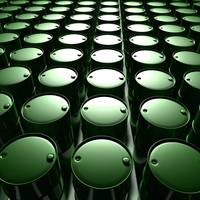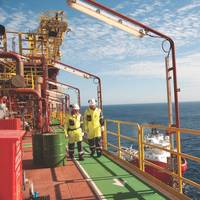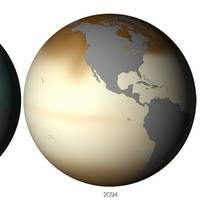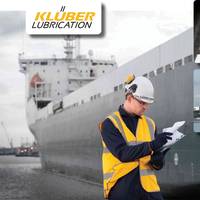Shed the Satellite: Quantum Sensors hold Promise for Future GPS-Free Navigation

Don’t let the titanium metal walls or the sapphire windows fool you. It’s what’s on the inside of this small, curious device that could someday kick off a new era of navigation.For more than a year, the avocado-sized vacuum chamber has contained a cloud of atoms at the right conditions for precise navigational measurements. It is the first device that is small, energy-efficient and reliable enough to potentially move quantum sensors — sensors that use quantum mechanics to outperform conventional technologies — from the lab into commercial use…
Clean Crude? Oil Companies use Offsets to Claim Green Barrels

In January, Occidental Petroleum announced it had accomplished something no oil company had done before: It sold a shipload of crude that it said was 100% carbon-neutral.While the two-million-barrel cargo to India was destined to produce more than a million tons of planet-warming carbon over its lifecycle, from well to tailpipe, the Texas-based driller said it had completely offset that impact by purchasing carbon credits under a U.N.-sponsored program called CORSIA.Carbon credits…
Earth, Wind & … Fire Protection

Three years ago coatings giant Jotun was buying up real estate for U.S. market access and location savings. The effort to get closer to its shipping and offshore customer base is still underway with research aimed at protecting client assets in frontier areas like the arctic. An R&D expansion at Flixborough in the U.K. and in the Arctic archipelago of Spitsbergen aims to make active the fire response of passive surface treatments. There’s a need to address fires in enclosed steel workplaces plus high-temperature hydrocarbon fires.
PPG Unveils New Coating for Dry Bulk Cargo Holds

Debuting its latest offering at Posidonia 2016, PPG’s protective and marine coatings business has unveiled a new protective system for dry bulk carrier cargo holds: the PPG SIGMASHIELD MTC system, built on coating technology that comprises a PPG SIGMASHIELD PRIME undercoat and PPG SIGMASHIELD MTC topcoat. Designed specifically for the cargo holds of dry bulk carriers, the system’s chemistry maximizes technical performance and offers a commercially sound solution for spot and full repairs as well as for application at newbuild, PPG said.
The Lowdown on Ocean Acidification

Scientists say that the world’s oceans are acidifying. This term is correct, but somewhat misleading. Until recently, the oceans have had (so far as can be determined) a pH level of about 8.4 for millennia. A pH of 7.0 is neutral. Thus, the oceans are alkaline, not acidific. But, since the beginning of the industrial age when emissions of carbon dioxide started to rise, the oceans’ pH level has dropped to 8.3 and the waters have become less alkaline. Some argue that that is not a big change in 200 years. But it is the largest change known to have occurred in 20 million years.
Chinese Submarine Dives into Indian Ocean
A Chinese submarine has started to search an area of the Indian Ocean for seabed deposits of gold, silver, copper and zinc, in a four-month-long mission. A Chinese submersible vessel has been conducting its first deep dive in the Indian Ocean in search of rare metals. It will collect samples of hydrothermal fluid and sulfide, which is a kind of seabed deposit that contains copper, zinc and many precious metals such as gold and silver, official Xinhua news agency said. The project, which involves exploring the Indian Ocean for 120 days, reflects China's hunger for resources, sources say. The vessel will also obtain samples of rocks, sediment and water from selected spots in the India Ocean.
'Fantasy Fuel': Novozymes Looks to the Future
When Denmark's Novozymes first wondered in 2000 how its mass-produced enzymes could be used to make advanced biofuel, the industry did not exist and only now is the fruit of its labour emerging after years of being lampooned as a "fantasy fuel". But as commercial production of transportation fuel made from plant waste rather than valuable corn finally starts in the United States, Brazil and Europe, Novozymes has already turned its gaze towards bioplastics and even diapers. With the biofuels sector waging a drawn-out regulatory battle with 'Big Oil' over potentially damaging cuts to biofuel targets in the United States, Novozymes says it has contingency plans.
The ABCs of EALs for the EPA’s VGP

When the Environmental Protection Agency (EPA) issued the new Vessel General Permit (VGP) in December 2013, lubricant and fluid manufacturers were prepared to give vessel owners a number of environmentally acceptable lubricants (EAL) to work with. EAL usage is now essentially required for any application on vessels where incidental lubricant discharge could occur in the marine environment. Those applications include stern tubes, thrusters, stabilizers, CPP propellers, and wire rope and mechanical equipment immersed in water during normal operation.
NOAA: Air Pollution Plummets when Ships Shift Fuels
New clean fuel regulations in California and voluntary slowdowns by shipping companies substantially reduce air pollution caused by near-shore ships, according to a new NOAA-led study published online today in Environmental Science & Technology. The study examined a container ship operating under a 2009 California regulation requiring that ships switch to low-sulfur fuels as they approach the California coast, and also adhering to a voluntary state slowdown policy, intended to reduce pollution. The research team found that emissions of several health-damaging pollutants, including sulfur dioxide and particulate matter, dropped by as much as 90 percent.
Hypothermia: A Potential Killer Anytime, Anywhere
It was March in South Louisiana and the last real cold front of the year whipped the water into an angry, foamy mass of three ft. high waves. A small workboat bounced against the pilings as two workers and their supervisor loaded their gear in preparation for servicing an oil well located in a nearby bay. Struggling to stay on his feet, one of the workers told the supervisor he didn't think it was a good idea to go out in such a small boat under such rough conditions. The supervisor smiled condescendingly and dismissed the advice. Silently, the workers braced themselves as the supervisor revved the outboard and the boat pulled away from the dock. After a long, tiring day of fighting wind and waves, the men completed their work and headed back toward the dock.





